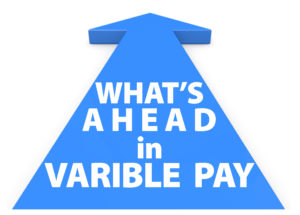Variable pay has evolved greatly over the past five to 10 years, and is expected to change more in the future. However, variable pay programs and changes to them have not occurred without challenges.

Prior to the 1970s, the concept of the annual bonus was primarily reserved for the executive level and based on discretionary payments for accomplishing individual objectives. The need for employers to better control their fixed costs led to variable pay in the broader workforce. Organizations also saw that these programs were effective in focusing employees on critical objectives, motivating the achievement of desired results, influencing the way they performed their work, and helping to better align programs and work efforts with the organization’s mission and strategy.
What’s New?
Variable pay has been on the leading edge of one of the foremost changes in compensation philosophy since formal compensation programs were introduced. It has been driven by shrinking expenditures on salary increases, rising cost of employee benefits, and large increases in funding and expenditures on broad-based employee bonuses. Since variable pay increases do not add to, or compound, future costs and are usually dependent on performance results, companies have expanded their overall compensation investment with greater spending on variable pay.
During the past 25 years, salary increase spending has been cut in half (from 5.5 to 2.8 percent of payroll), while funding for bonuses has tripled (from 4.2 to 12.8 percent of payroll), according to AON Hewitt surveys from 1990 to 2017. Variable pay has filled the gap this created in compensation growth.
The shift in spending from salary increases to variable pay has been in parallel with the expectation that bonus programs would become much more important for achieving pay for performance. Initially, broad-based bonus programs focused mostly on organizational goals. Profit-sharing and gain-sharing plans were early examples. In recent years, there has been a drive to create a stronger line of sight in variable pay plans by incorporating greater managerial discretion and a greater focus on individual performance.
What’s Next?
Recent trends and approaches in variable pay programs show several future directions. Organizations will break away from one-size-fits-all plans to ones that have a small common enterprise-wide component and varying measures and weights intended to better measure the performance of a business unit, function or department. Calibrated plans will take the place of homogeneous plans, and we will see more winners and losers within the organization based on different levels of achievement.
Greater use of qualitative measures will also increase. Early generations of incentive plans relied heavily on quantitative measures. There is a growing recognition that critical outcomes and employee behaviors can be enticed by programs that do not use quantitative formulae. However, these qualitative measures may not be always precisely measured.
In the future, almost all variable pay programs will increase or decrease payouts based on individual performance achievement. In the next 5 to 10 years, this will become a mainstay in pay for performance plans.
Levels of spending on broad-based variable pay plans will also continue to increase as organizations expect it to continue to grow. This will most likely be the result of shifting funds from other rewards programs, such as salary growth and some benefits programs.
What’s Challenging?
Variable pay programs have their difficulties. Many organizations struggle to identify the right measures and weightings. Some have too many measures, which leads to diluting their relevance. Some have too strong a reliance on quantitative goals, where measuring outcomes qualitatively may better represent the organization’s strategic goals. And some are stuck on historical measures that have been used in the past and are unwilling to give them up.
More organizations are implementing an individual pay for performance component to their programs. But according to the recent AON Hewitt survey, employers have had no greater success in differentiating rewards by performance level than what they have experienced with their salary programs. The keys to successfully implementing a pay for performance component of variable pay plans is the quality of goal setting, manager training and accountability for differentiating, and the ability to define differences in employee performance.
Effective communication of variable pay continues to be an area of difficulty for organizations. Employees must know what is expected of them, and it should occur at the beginning of the planned year. Additionally, it is critical that employees receive feedback throughout the year. Furthermore, periodic feedback of results vs. organization-wide goals should occur at least quarterly.
Evolving Role of Variable Pay. In the past two decades, variable pay has gone from applying to only the top executives to the primary driver of pay for performance for all employees in the organization. The concepts of variable pay continue to evolve as organizations push them down further in the organization. What will not change is the growing importance of variable pay and the expectation for shaping employee behaviors and motivating the achievement of key business outcomes.
Please contact me at nlappley@lappley.com or (847) 921-2812 to discuss any comments or questions you may have regarding the implementation of variable pay programs in your organization. Feel free to forward this email to anyone else who may be interested.
